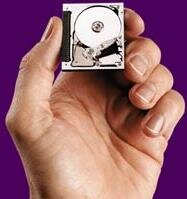Where Did That iPod Come From?
Few topics are more controversial among people who study histories of science and technology than the categories of basic versus applied research. In part, it's because the borders between basic vs. applied research shifts over time. What was "basic" in 1880 might be applied (or simply black-boxed knowledge) a few decades later. Moreover, even within one particular time period, the labels "basic" vs "applied" are actors' categories. They're contingent on the circumstances in which researchers deploy them and the rhetorical work they (and we) want them to do.
I was reminded of these distinctions this week when the Technology Academy Finland announced the recipient of its prestigious Millennium Technology Prize (and a cool 1 million euros). The winner is Stuart S.P. Parkin, an IBM Fellow based at the Almaden Research Centre in San Jose as well as the director of the Max Planck Institute of Microstructure Physics. Parkin is being honored for his discoveries which have "enabled a thousand-fold increase in the storage capacity of magnetic disk drives." These innovations, according to the Finns, have "underpinned the evolution of large data centers and cloud services, social networks, music and film distribution online."Parkin's work is especially illuminating for the "what is science and what is technology?" question given the historical background of his work. The origins of it go back to basic physics research carried out in the late 1980s in France and Germany. In 1988, Albert Fert and Peter Grünberg independently discovered that tiny changes in magnetism can produce unexpectedly strong electrical signals. Because the response was so much greater than any of them expected, they named the phenomenon giant magnetoresistance (GMR). ((Peter Grünberg, then at the Jülich Research Center in western Germany, and his team made their discovery using Fe/Cr/Fe tri-layers. At the same time, Albert Fert and his group at Laboratoire de Physique des Solides at the University of Paris-Sud were examining more complex Fe/Cr multilayers. Fert and Grünberg’s work represented nanotechnology research long before the word itself fully entered the popular lexicon. For example, Fert’s team prepared its alternating iron and chromium layers – each less than ten nanometers thick – with molecular beam epitaxy, a key proto-nano research tool, before observing the GMR effect.)) In mid-1988, both the French and the German research teams presented their results at a conference in France and submitted their studies for publication in the Physical Review. Aware now of each other’s work, the two scientists agreed to share credit for the discovery. Their work also helped initiate a new field of interdisciplinary research called spintronics which blends novel solid-state physics and device engineering with well-established areas of research such as magnetics and materials science.
Parkin is being honored for his discoveries which have "enabled a thousand-fold increase in the storage capacity of magnetic disk drives." These innovations, according to the Finns, have "underpinned the evolution of large data centers and cloud services, social networks, music and film distribution online."Parkin's work is especially illuminating for the "what is science and what is technology?" question given the historical background of his work. The origins of it go back to basic physics research carried out in the late 1980s in France and Germany. In 1988, Albert Fert and Peter Grünberg independently discovered that tiny changes in magnetism can produce unexpectedly strong electrical signals. Because the response was so much greater than any of them expected, they named the phenomenon giant magnetoresistance (GMR). ((Peter Grünberg, then at the Jülich Research Center in western Germany, and his team made their discovery using Fe/Cr/Fe tri-layers. At the same time, Albert Fert and his group at Laboratoire de Physique des Solides at the University of Paris-Sud were examining more complex Fe/Cr multilayers. Fert and Grünberg’s work represented nanotechnology research long before the word itself fully entered the popular lexicon. For example, Fert’s team prepared its alternating iron and chromium layers – each less than ten nanometers thick – with molecular beam epitaxy, a key proto-nano research tool, before observing the GMR effect.)) In mid-1988, both the French and the German research teams presented their results at a conference in France and submitted their studies for publication in the Physical Review. Aware now of each other’s work, the two scientists agreed to share credit for the discovery. Their work also helped initiate a new field of interdisciplinary research called spintronics which blends novel solid-state physics and device engineering with well-established areas of research such as magnetics and materials science. In 2007, the two European scientists shared the Nobel prize for physics. Yay! But what happened between 1988 and 2007 is the key here...and this is where Parkin entered the picture.The first commercial application of the GMR phenomenon was in devices to detect slight magnetic fields for applications like landmine detection and traffic control systems. While sensor devices were fine for niche applications, other companies were eager to apply the GMR effect to more lucrative markets. This included IBM and the researchers it employed at its Almaden lab, a place where there was already a long tradition of work on magnetic information storage technologies.Parkin was one of the IBM researchers who undertook this research. In 1980, Parkin earned his doctorate in physics while working at the Cavendish Laboratory in Cambridge. Still in his twenties, he joined IBM Almaden laboratory in 1982 and did research on topics such as high-temperature superconductivity for several years. After learning about the Europeans’ GMR research, he began to explore the magnetic properties of multilayer thin films with an eye toward improving the capabilities of the company’s hard disk drives.In 1991, Parkin and his colleagues described what they called a “spin valve,” a device that makes use of the GMR phenomenon. ((As described in its basic form, a spin valve is composed of two magnetic layers separated by a nonmagnetic layer. When the magnetic moment of the magnetic layers are aligned, electrons move more easily and the sample shows low resistance. If the magnetic layers are not aligned, the spin-dependent movement of electrons is impeded and resistance goes up. In this way, the device acts as a valve, affecting the passage of electrons depending on whether the valve is “open” or “closed. At about the same time, Parkin and four other colleagues filed for a patent. This was awarded in October 1992.))Unlike Fert and Grünberg, who built samples using the more precise but slower and expensive tool of molecular beam epitaxy, Parkin’s group tried using sputter deposition equipment. This fit the goals of the Almaden group which wasn’t on basic science per se but on making devices that could be readily manufactured. Parkin’s use of sputtering held appeal for a company like IBM which had extensive experience in fabricating sputter-deposited magnetic storage media on an industrial scale. As one observer of Parkin’s research later recalled, the British scientist and his colleagues “simply engineered the shit” out the underlying GMR discovery as they made and characterized over 30,000 different multilayer combinations.IBM eventually used the spintronics research Parkin and his colleagues had done to redesign and improve a basic element - the read head - in the company’s hard disk drives.
In 2007, the two European scientists shared the Nobel prize for physics. Yay! But what happened between 1988 and 2007 is the key here...and this is where Parkin entered the picture.The first commercial application of the GMR phenomenon was in devices to detect slight magnetic fields for applications like landmine detection and traffic control systems. While sensor devices were fine for niche applications, other companies were eager to apply the GMR effect to more lucrative markets. This included IBM and the researchers it employed at its Almaden lab, a place where there was already a long tradition of work on magnetic information storage technologies.Parkin was one of the IBM researchers who undertook this research. In 1980, Parkin earned his doctorate in physics while working at the Cavendish Laboratory in Cambridge. Still in his twenties, he joined IBM Almaden laboratory in 1982 and did research on topics such as high-temperature superconductivity for several years. After learning about the Europeans’ GMR research, he began to explore the magnetic properties of multilayer thin films with an eye toward improving the capabilities of the company’s hard disk drives.In 1991, Parkin and his colleagues described what they called a “spin valve,” a device that makes use of the GMR phenomenon. ((As described in its basic form, a spin valve is composed of two magnetic layers separated by a nonmagnetic layer. When the magnetic moment of the magnetic layers are aligned, electrons move more easily and the sample shows low resistance. If the magnetic layers are not aligned, the spin-dependent movement of electrons is impeded and resistance goes up. In this way, the device acts as a valve, affecting the passage of electrons depending on whether the valve is “open” or “closed. At about the same time, Parkin and four other colleagues filed for a patent. This was awarded in October 1992.))Unlike Fert and Grünberg, who built samples using the more precise but slower and expensive tool of molecular beam epitaxy, Parkin’s group tried using sputter deposition equipment. This fit the goals of the Almaden group which wasn’t on basic science per se but on making devices that could be readily manufactured. Parkin’s use of sputtering held appeal for a company like IBM which had extensive experience in fabricating sputter-deposited magnetic storage media on an industrial scale. As one observer of Parkin’s research later recalled, the British scientist and his colleagues “simply engineered the shit” out the underlying GMR discovery as they made and characterized over 30,000 different multilayer combinations.IBM eventually used the spintronics research Parkin and his colleagues had done to redesign and improve a basic element - the read head - in the company’s hard disk drives. In November 1997, The Wall Street Journal carried a front-page story about IBM’s unveiling of a new innovation for the personal computer industry. Based on the Almaden group’s exploitation of the GMR phenomenon, the new drives featured exquisitely sensitive magnetic read heads. For example, they could store eight times as much data as competitor’s equipment while still being smaller in size. ((Raju Narisetti. “IBM Unveils Powerful PC Disk Drive, Confirms Plans to Join Two Divisions.” The Wall Street Journal, November 10, 1997: 1. IBM’s device held about 17 gigabytes of data (double what the company had previously offered) and was 3.25” in size; the best products from other firms had about thirty percent less storage capacity and were two inches bigger.)) This helped set the stage for the subsequent explosion in computer memory.
In November 1997, The Wall Street Journal carried a front-page story about IBM’s unveiling of a new innovation for the personal computer industry. Based on the Almaden group’s exploitation of the GMR phenomenon, the new drives featured exquisitely sensitive magnetic read heads. For example, they could store eight times as much data as competitor’s equipment while still being smaller in size. ((Raju Narisetti. “IBM Unveils Powerful PC Disk Drive, Confirms Plans to Join Two Divisions.” The Wall Street Journal, November 10, 1997: 1. IBM’s device held about 17 gigabytes of data (double what the company had previously offered) and was 3.25” in size; the best products from other firms had about thirty percent less storage capacity and were two inches bigger.)) This helped set the stage for the subsequent explosion in computer memory. The result? Tiny hard drives that Apple incorporated into its early iPods. Fert and Grünberg’s work - channeled through Parkin and his colleagues at Almaden - found its way into the hands of millions of earbud wearing teenagers and subway commuters.Historians, recognize that “pure science” is very much a social construction and one that often, after closer scrutiny, may not be quite so uncomplicated. Fert and Grünberg originally discovered GMR in the tradition of small-scale basic physics research. Parkin helped translate this into practical applications. Businesses, large and small, swiftly patented these applications and integrated it into products worth billions of dollars in annual sales. In this week's Millennium Prize announcement, we can discern connections between contemporary scientific research and engineering applications and also see the shifting boundaries between science and technology.
The result? Tiny hard drives that Apple incorporated into its early iPods. Fert and Grünberg’s work - channeled through Parkin and his colleagues at Almaden - found its way into the hands of millions of earbud wearing teenagers and subway commuters.Historians, recognize that “pure science” is very much a social construction and one that often, after closer scrutiny, may not be quite so uncomplicated. Fert and Grünberg originally discovered GMR in the tradition of small-scale basic physics research. Parkin helped translate this into practical applications. Businesses, large and small, swiftly patented these applications and integrated it into products worth billions of dollars in annual sales. In this week's Millennium Prize announcement, we can discern connections between contemporary scientific research and engineering applications and also see the shifting boundaries between science and technology.
